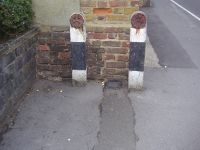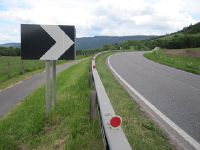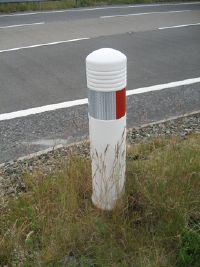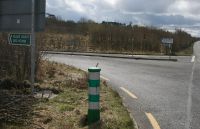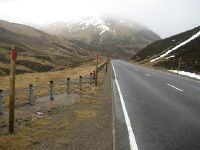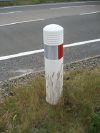Warning Sign/Edge of Carriageway Marker
| Edge-of-carriageway marker | |||
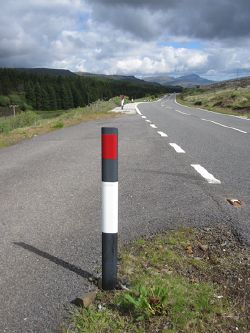 | |||
| Red nearside marker mounted on a plastic post | |||
| |||
| TSRGD ref : | 560, 561 | ||
| From : | 1964 | ||
| To : | present | ||
Placement of sign requirements
Information correct as of Traffic Signs Regulations and General Directive 2016 and Traffic Signs Manual (2019)
Requirements
- Between 75 and 150 mm diameter (if round). Between 45 and 180 square cm is rectangular
- Either Red, Amber or White
Safety posts and discs
Roadside posts painted with broad horizontal black and white bands and bearing small circular reflectors set in a larger disc at the top – officially termed safety posts and discs – came into use to mark the edge of the carriageway in hazardous locations, or to warn of other obstructions near the edge of the road, in the early part of the 20th century. Red reflectors were used on the nearside of the road and white on the offside.
Hazard markers
As modified since application of the recommendations contained in the Warboys Report (1964), similar warning devices – now called hazard markers in the regulations – are reflective discs (diagram 560) or rectangles (diagram 561), using the same colours of red on the lefthand edge of the carriageway and white on the righthand edge of a single-carriageway road, together with amber on the righthand edge of a road carrying traffic in one direction only or adjacent to the central reservation of a dual-carriageway road.
They may be fixed to barriers, walls, safety fence posts, or any other object or structure adjacent to the carriageway. Where they are mounted on posts, these are also reflective, with alternate black and white horizontal bands, each between 225 and 350 mm deep. Post-mounted markers are generally rectangular and may be curved to fit the circular or elliptical cross-section of the post.
On single-carriageway roads the markers are frequently dual sided so that they are red on one side (facing traffic whose nearside they are on) and white on the reverse (as seen by traffic coming in the opposite direction).
Junction marker posts
Some authorities mark selected road junctions with a modified form of edge-of-carriageway marker. These are usually white plastic posts, often of a slightly wider diameter than the normal black and white ones but using the same coloured reflective markers, often in a band around the circumference of the post. These posts are positioned either side of a junction or other road access point to highlight its position.
Junction definition posts (Ireland)
In the Republic of Ireland "junction definition posts" (sign F 902 in the Department of Transport's Traffic Signs Manual 2010) may be used to indicate the location of side roads. Circular in cross-section and about one metre high, they are coloured dark green (non-reflective) at top and bottom with reflective white and light green intermediate bands.
Snow poles
Snow poles – which are edge-of-carriageway markers of considerably greater height than normal – may be used in areas prone to heavy snowfall (or to drifting which could hide standard-height markers) to provide a permanent indication of the edge of the carriageway to the operators of winter road maintenance and clearing plant.
Gallery
